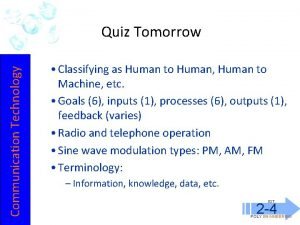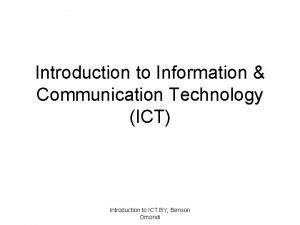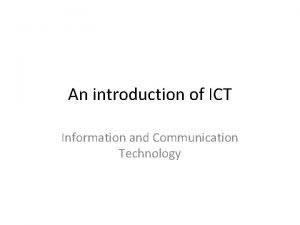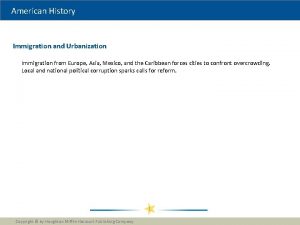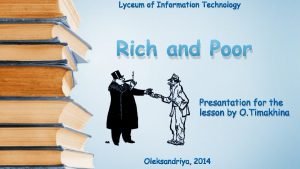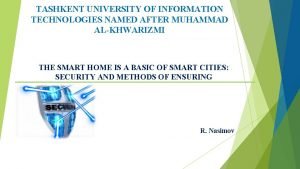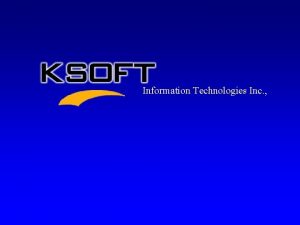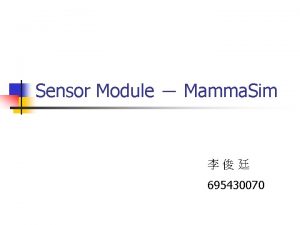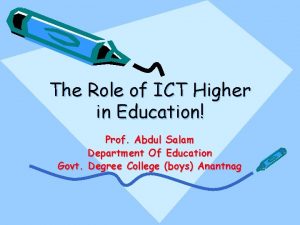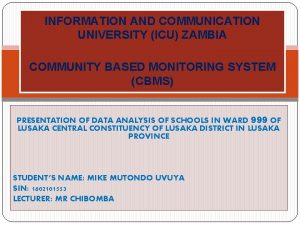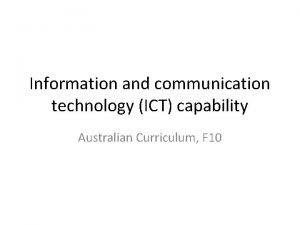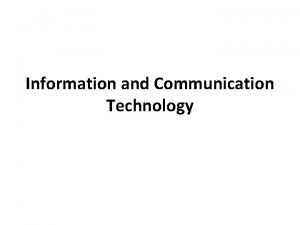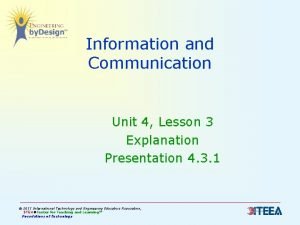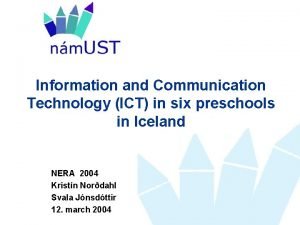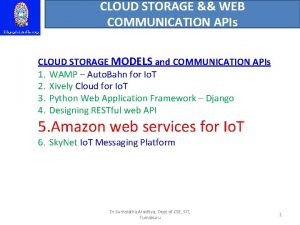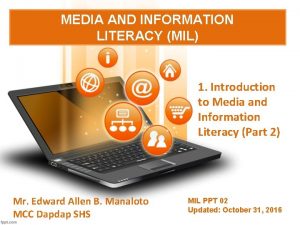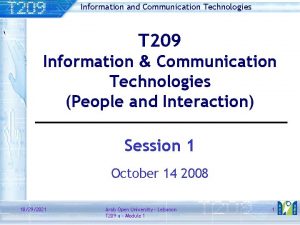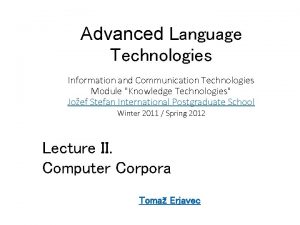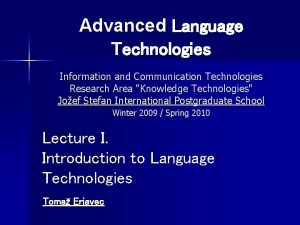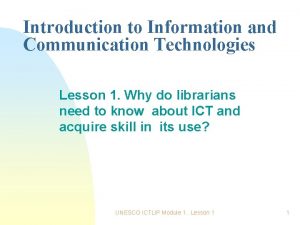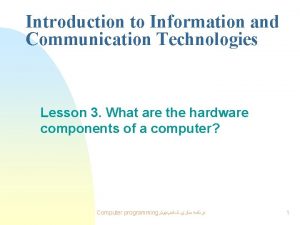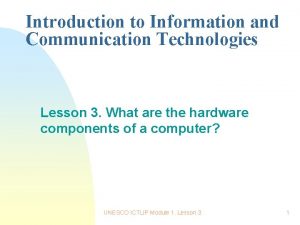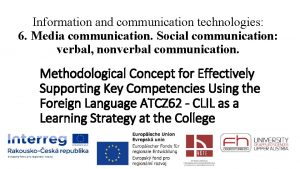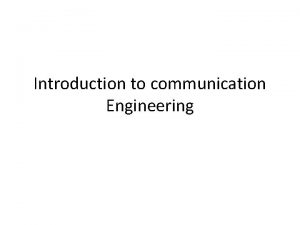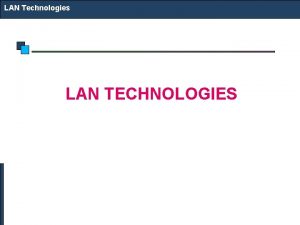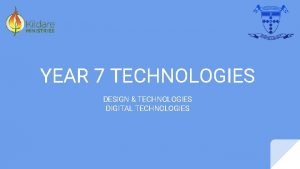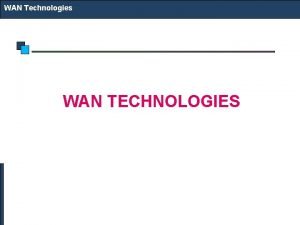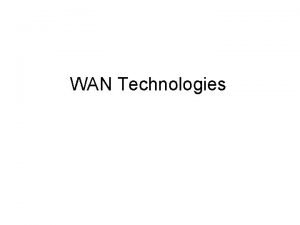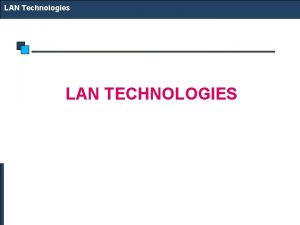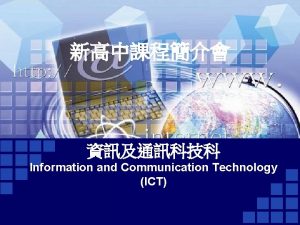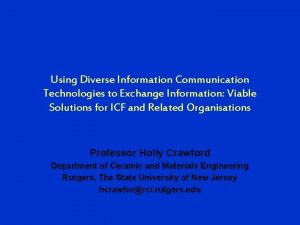Introduction to Information and Communication Technologies Lesson 6



























- Slides: 27

Introduction to Information and Communication Technologies Lesson 6. What is the Internet? UNESCO ICTLIP Module 1. Lesson 6 1

Scope n n n n What is the Internet ? What Internet tools are available? What is the World Wide Web? What is e-mail? FTP? Chat? What are online information resources? Why is the Internet important to libraries? What are some issues and concerns in using the Internet? UNESCO ICTLIP Module 1. Lesson 6 2

Learning outcomes n n n By the end of this lesson, you should be able to: Define what is the Internet and other Internet concepts and terms. Describe Internet tools and services. Identify information resources for libraries on the Internet. Use online information resources on the Internet. Realize the importance of Internet to libraries. Discuss some issues and concerns regarding the use of Internet in libraries. UNESCO ICTLIP Module 1. Lesson 6 3

What is the Internet? The Internet is a global network of computers communicating under one set of guidelines, formally called Transmission Control Protocol/Internet Protocol (TCP/IP). UNESCO ICTLIP Module 1. Lesson 6 4

The Internet is more than a physical network of wires linking individual computers to one another. It is also a network of people and information resources. UNESCO ICTLIP Module 1. Lesson 6 5

The Internet is not a specific place, company, or service, although places, companies and services are accessible via the Internet. Nobody owns the Internet. UNESCO ICTLIP Module 1. Lesson 6 6

How do you connect to the Internet? Basically you will need: n a personal computer n a modem and a telephone line n an Internet Service Provider (provides the software, the IP address, and the link to the Internet) n a network card if connecting to home or office network UNESCO ICTLIP Module 1. Lesson 6 7

What can you do on the Internet? n n n World Wide Web Electronic Mail FTP Talk/Chat Online information resources Others UNESCO ICTLIP Module 1. Lesson 6 8

The World Wide Web is the collective name for all the computer files in the world that are : n accessible through the Internet located on and provided by a large number of Web servers n electronically linked together, made possible by Hyper. Text Transfer Protocol (HTTP) and Hyper. Text Markup Language (HTML), ; n viewed, experienced or retrieved through a “browser” program running on your computer UNESCO ICTLIP Module 1. Lesson 6 9

The Web components n n n Web browsers and servers - Web browsers are application software used to access files or applications which are located and run by Web servers. Web contents - files in several formats text, multimedia, video, audio, etc. . . that are available through the World Wide Web HTTP and HTML - HTTP is the protocol used in World Wide Web to transfer files from one computer to another while HTML is used to format and display Web pages containing UNESCO ICTLIP Module 1. Lesson 6 10

Web browsers and servers 5. User receives file 4. Server sends requested files to browser to be interpreted. Browser 1. User sends request 3. Server accepts and processes 2. Browser interprets user’s request from selection and makes request from UNESCO ICTLIP Module 1. Lesson 6 11 browser. appropriate server.

Examples of browsers n n n Netscape Navigator Microsoft Internet Explorer Opera Neoplanet Lynx More… UNESCO ICTLIP Module 1. Lesson 6 12

Netscape Navigator UNESCO ICTLIP Module 1. Lesson 6 13

Microsoft Internet Explorer UNESCO ICTLIP Module 1. Lesson 6 14

Web Content • Text • Sound • Images • Video • Animation • Full-text • Statistical data • Abstracts/Indexes • Software • Library catalogs • News • And more UNESCO ICTLIP Module 1. Lesson 6 15

HTTP and HTML n n n Web servers and browsers use Hyper. Text Transfer Protocol (HTTP), an Internetstandard protocol, to handle the transfer of text and other files between different computers. HTTP “defines how messages are formatted and transmitted, and what actions Web servers and browsers should take in response to various commands. ” HTML defines how Web pages are formatted and displayed by web browsers UNESCO ICTLIP Module 1. Lesson 6 16

Hyperlinks between Web resources n n Hyperlinks are special HTML codes included in Web pages that connect Web resources, instruct the browser to fetch a resource, run an application or jump to another site. Hyperlinks consist of the following: u HTML tags - instruct Web browser and Web servers what file to get or what program to run, includes URL’s and/or pointers to applications and files to run u Anchor – text or image used to place a hyperlink, the clickable object that activates the hyperlink u Uniform Resource Locators (URL) – address of the Web resources UNESCO ICTLIP Module 1. Lesson 6 17

Sample URL’s n n n n http: //lcweb. loc. gov http: //www. ifla. org http: //www. ala. org http: //library. albany. edu/internet/ http: //www. internet 101. org/ http: //whatis. techtarget. com/ http: //webopedia. internet. com/ UNESCO ICTLIP Module 1. Lesson 6 18

Electronic Mail (email) n n Uses: uexchange correspondence utransfer documents usubscribe to news services uget computer software Format: username@hostname. domain example: me@hotmail. com UNESCO ICTLIP Module 1. Lesson 6 19

Transferring files from one computer to another n n n The File Transfer Protocol (ftp) allows you to copy a file from a remote computer to your desktop and vice versa Syntax: uftp <ftp. sunsite. edu> Logging in uusername upassword UNESCO ICTLIP Module 1. Lesson 6 20

Real-time communication using the Internet n n n Talk / ytalk utalk <user address> IRC - Internet Relay Chat uirc <nickname> <irc server> Freetel, i. Phone, etc. UNESCO ICTLIP Module 1. Lesson 6 21

What are online information resources? n n n Locally available databases: library catalogs, abstracts and indexes, full-text, multimedia Directly available from hosts: abstracts and indexes, full-text, multimedia Available via the Internet: abstracts, indexes, e-journals and other full text documents, multimedia UNESCO ICTLIP Module 1. Lesson 6 22

Online information resources Multimedia Abstracts and Indexes Music Sound Full-text documents Video UNESCO ICTLIP Module 1. Lesson 6 23

Internet accessible library catalogs and databases n n Many libraries have published their library catalogs on the Internet. Databases (abstracts and indexes) are accessible online via the Net. Some charge fees but some are free. UNESCO ICTLIP Module 1. Lesson 6 24

Online databases / references n n n Library of Congress Catalog OCLCs First Search. Commercial services: EBSCO, ISI H. W. Wilson, OVID Encyclopedias, dictionaries, directories, newspapers Other UNESCO ICTLIP Module 1. Lesson 6 25

Why is the Internet important to librarians? 1. Many information resources may be accessed through the Internet: uonline library catalogs udocuments in various formats udatabases ueducational and information services 2. Documents can be sent through the Internet (e. g, e-mail, FTP, file-sharing) 3. Librarians can communicate with people using e-mail, chat, newsgroups etc… UNESCO ICTLIP Module 1. Lesson 6 26

Issues n n n n Copyright Privacy Security Netiquette Censorship Quality Quantity Archiving UNESCO ICTLIP Module 1. Lesson 6 27
 Information systems and communication technologies quiz
Information systems and communication technologies quiz Technologie de l'information
Technologie de l'information Introduction of ict
Introduction of ict Introduction to ict
Introduction to ict Discuss the current technologies of media and information
Discuss the current technologies of media and information Transcontinent
Transcontinent Lyceum of information technologies
Lyceum of information technologies Tashkent university of information technologies
Tashkent university of information technologies Vision information technologies
Vision information technologies Layer 2 wan technologies
Layer 2 wan technologies Emerging technologies introduction
Emerging technologies introduction What is oral communication and written communication
What is oral communication and written communication What is oral communication and written communication
What is oral communication and written communication Microcontroller communication
Microcontroller communication Information communication technology
Information communication technology Media literacy and information literacy venn diagram
Media literacy and information literacy venn diagram Who do you think are people media?
Who do you think are people media? Emphancy
Emphancy Information and communication technology capability meaning
Information and communication technology capability meaning What is ict means
What is ict means Components of information and communication technology
Components of information and communication technology Definition information and communication technology
Definition information and communication technology Introduction to cloud storage models and communication apis
Introduction to cloud storage models and communication apis What is the message in this cartoon mil
What is the message in this cartoon mil Micro teach lesson plan example
Micro teach lesson plan example Sat vocabulary lesson and practice lesson 4
Sat vocabulary lesson and practice lesson 4 The science duo physical and chemical changes
The science duo physical and chemical changes Lesson 4 gravity and motion lesson review
Lesson 4 gravity and motion lesson review
